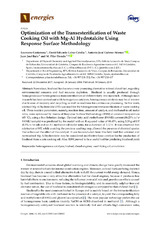Optimization of the Transesterification of Waste Cooking Oil with Mg-Al Hydrotalcite Using Response Surface Methodology
Autor
Costarrosa Morales, Laureano
Leiva-Candia, David Eduardo
Cubero-Atienza, Antonio J.
Ruiz, Juan José
Dorado, M.P.
Editor
MDPIFecha
2018Materia
Heterogeneous catalysisBiofuel
Diesel engines
Used frying oil
Simulation
METS:
Mostrar el registro METSPREMIS:
Mostrar el registro PREMISMetadatos
Mostrar el registro completo del ítemResumen
Nowadays, biodiesel has become a very promising alternative to fossil diesel fuel, regarding
environmental concerns and fuel resource depletion. Biodiesel is usually produced through
homogeneous or heterogeneous transesterification of different fatty raw materials. Although main
research has been carried out with homogenous catalysts, heterogeneous catalysts may be of interest
due to ease of recovery and recycling, as well as readiness for continuous processing. In this work,
calcined Mg-Al hydrotalcite (HT) was used for the heterogeneous transesterification of waste cooking
oil. Three reaction parameters, namely, reaction time, amount of catalyst, and methanol-to-oil molar
ratio, were optimized by means of Response Surface Methodology (RSM) at constant temperature
(65 C), using a Box-Behnken design. Optimal fatty acid methyl ester (FAME) content (86.23% w/w
FAME/sample) was predicted by the model with an R-squared value of 98.45%, using 3.39 g of HT
(8.5% w/w oil) and an 8:1 methanol-oil molar ratio, for a duration of 3.12 h. It was observed that
calcination of HT, while avoiding the previous washing step, allowed the presence of chemical species
that enhanced the effect of the catalyst. It can be concluded from this field trial that calcined and
nonwashed Mg-Al hydrotalcite may be considered an effective basic catalyst for the production of
biodiesel from waste cooking oil. Also, RSM proved to be a useful tool for predicting biodiesel yield.

